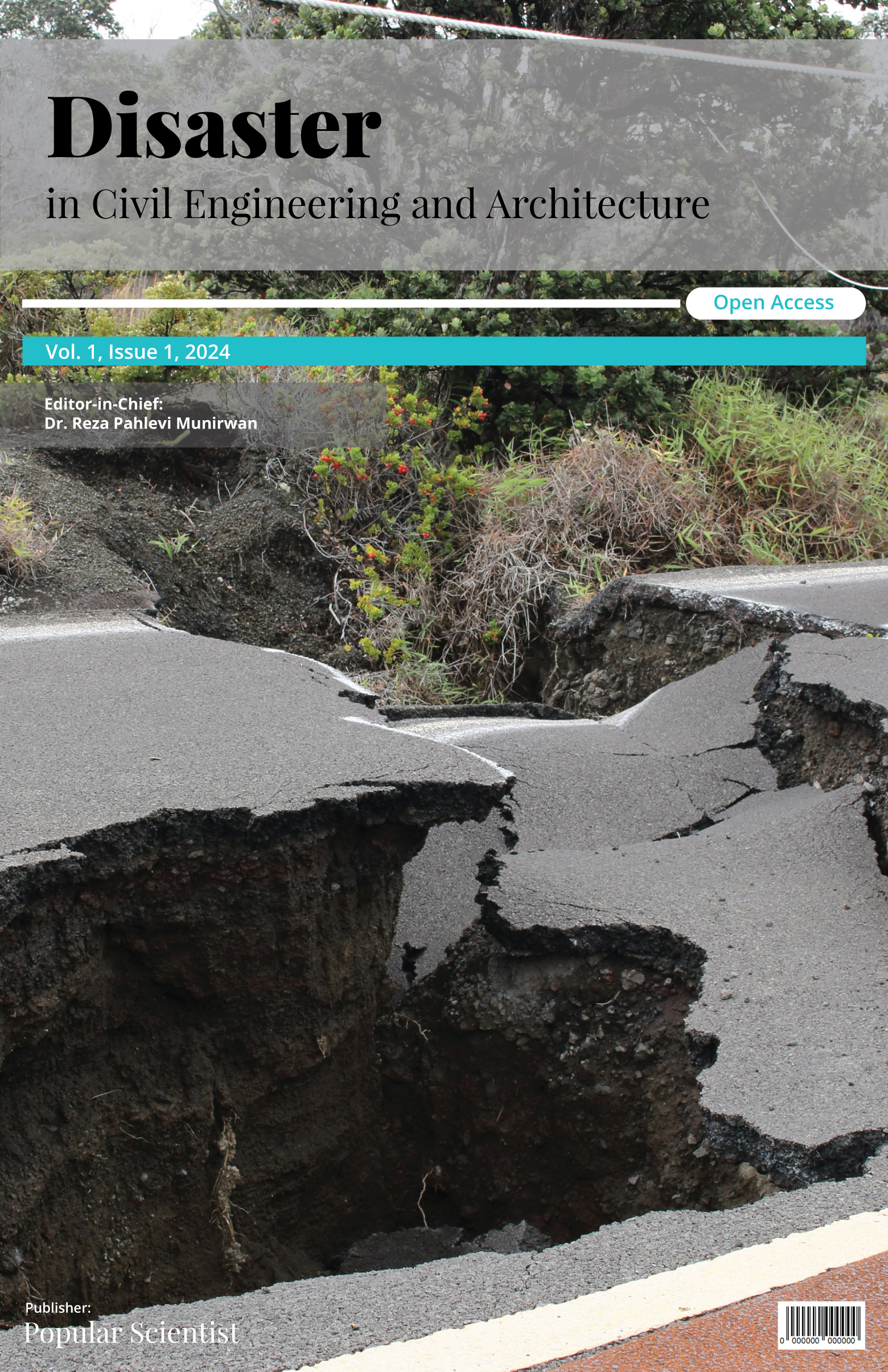Assessing the Viability of Wood Ash as a Filler in Asphalt Mixtures
DOI:
https://doi.org/10.70028/dcea.v1i1.9Keywords:
Wood ash, Asphalt Mixtures, Stability, Strength, Abrasion lossAbstract
Waste management is increasingly crucial worldwide, and integrating agro-waste into pavement construction offers a promising approach for sustainability and enhanced material properties. This research investigates the use of wood ash as a filler in asphalt mixtures, using varying proportions of 0%, 2%, 4%, and 6% replacement by weight of asphalt. Experimental tests, including softening point, penetration, Marshall stability and flow, indirect tensile strength, and abrasion loss, were conducted to assess the influence of wood ash on asphalt mixture properties. The findings reveal that wood ash can improve certain performance aspects such as stiffness and density at an optimal content of 4%, balancing tensile strength and flow properties. However, higher wood ash percentages negatively affected the mixture's overall durability and stability. These results underscore the importance of optimizing wood ash content to enhance asphalt performance. This study demonstrates that wood ash is a sustainable alternative to conventional fillers in asphalt production, contributing to environmental conservation and waste management. Further research is recommended to explore various aggregate gradations, binder types, and the potential of wood ash as an asphalt modifier for quality improvement. Such studies are vital for advancing pavement technology, improving infrastructure quality, and addressing environmental challenges.
Downloads
References
United States Environmental Protection Agency 2022 Zero waste case study. San Francisco, 2022.
K. H. D. Tang, “Climate change in Malaysia: Trends, contributors, impacts, mitigation and adaptations,” 2019, Elsevier B.V. doi: http://dx.doi.org/10.1016/j.scitotenv.2018.09.316.
W. A. A. Q. I. Wan-Mohtar, N. I. Khalid, M. H. A. Rahim, A. A. I. Luthfi, N. S. M. Zaini, N. A. S. Din, and N. A. Mohd Zaini, “Underutilized Malaysian agro-industrial wastes as sustainable carbon sources for lactic acid production”. Fermentation, 9(10), 905. 2023.
N. S. A. Yaro, M. Napiah, M. H. Sutanto, A. Usman, and S. M. Saeed, “Performance evaluation of waste palm oil fiber reinforced stone matrix asphalt mixtures using traditional and sequential mixing processes,” Case Studies in Construction Materials, vol. 15, Dec. 2021, doi: http://dx.doi.org/10.1016/j.cscm.2021.e00783.
N. S. A. Yaro, M. Napiah, M. H. Sutanto, A. Usman, I. K. Mizwar, and A. M. Umar, “Engineering properties of palm oil clinker fine-modified asphaltic concrete mixtures,” Journal of Engineering and Technological Sciences, vol. 54, no. 2, Mar. 2022, doi: http://dx.doi.org/10.5614/j.eng.technol.sci.2022.54.2.5.
O. Fadele and M. Otieno, “Utilisation of supplementary cementitious materials from agricultural wastes: a review,” Proceedings of Institution of Civil Engineers: Construction Materials, vol. 175, no. 2, 2022, doi: http://dx.doi.org/10.1680/jcoma.19.00098.
H. A. Zahid and A. Iqbal, “Assessment of adhesion and moisture susceptibility of wood ashes modified Asphalt,” International Journal of Advanced Natural Sciences and Engineering Researches, vol. 4, no. 4, pp. 50–54, 2023, doi: http://dx.doi.org/10.59287/ijanser.2023.7.4.549.
L. S. de Moura, C. C. V. P. da Silva, S. M. de Oliveira, A. M. P. Carneiro, L. C. de F. L. Lucena, and A. C. V. da Nóbrega, “Use of calcium-rich wood biomass combustion ashes as filler in hot mix asphalt,” Road Materials and Pavement Design, vol. 23, no. 10, pp. 2375–2393, 2022, doi: http://dx.doi.org/10.1080/14680629.2021.1976253.
Y. C. Bi and F. M. Jakarni, “Evaluating properties of wood ash modified asphalt mixtures,” in IOP Conference Series: Materials Science and Engineering, Institute of Physics Publishing, Apr. 2019. doi: http://dx.doi.org/10.1088/1757-899X/512/1/012004.
R. Akter, Md. K. Hossain, Md. S. Anwar, and K. Rahman, “Performance evaluation of coal dust and wood powder ash as alternates of conventional filler in the asphalt concrete,” Sustainable Engineering and Innovation, vol. 4, no. 1, pp. 82–96, Apr. 2022, doi: http://dx.doi.org/10.37868/sei.v4i1.id157.
R. Mistry, S. Karmakar, and T. Kumar Roy, “Experimental evaluation of rice husk ash and fly ash as alternative fillers in hot-mix asphalt,” Road Materials and Pavement Design, vol. 20, no. 4, pp. 979–990, May 2019, doi: http://dx.doi.org/10.1080/14680629.2017.1422791.
A. Macior, I. Zaborniak, P. Chmielarz, J. Smenda, K. Wolski, E. Ciszkowicz, and K. Lecka-Szlachta, “A new protocol for ash wood modification: Synthesis of hydrophobic and antibacterial brushes from the wood surface,” Molecules, vol. 27(3), 2022, doi: http://dx.doi.org/10.3390/molecules27030890.
S. Dimter, M. Šimun, M. Zagvozda, and T. Rukavina, “Laboratory evaluation of the properties of asphalt mixture with wood ash filler”. Materials, 14(3), 575. 2021.
JKR Malaysia, “Standard Specification for Road Works, Section 4: Flexible Pavement,” pp. 1–187, 2008.
ASTM D5, “Standard Test Method for Penetration of Bituminous Materials,” 2013.
ASTM D36, “Standard Test Method for Softening Point of Bitumen (Ring-and-Ball Apparatus),” Manual on Hydrocarbon Analysis, 6th Edition, 2014, doi: http://dx.doi.org/10.1520/mnl10830m.
ASTM D6927, “Standard Test Method for Marshall Stability and Flow of Asphalt Mixtures,” ASTM International, vol. I, 2015.
ASTM D6931, “Standard Test Method for Indirect Tensile (IDT) Strength of Bituminous Mixtures 1,” 2012.
G. F. Huseien, M. Khamehchi, Z. Kubba, O. Benjeddou, and M.J. Mahmoodi, “Freeze-thaw cycle and abrasion resistance of alkali-activated FA and POFA-based mortars: Role of high volume GBFS incorporation”. Heliyon, 9(7). 2023.
S. N. A. Jeffry, R. P. Jaya, N. A. Hassan, H. Yaacob, J. Mirza, and S. H. Drahman, “Effects of nanocharcoal coconut-shell ash on the physical and rheological properties of bitumen,” Constr Build Mater, vol. 158, pp. 1–10, Jan. 2018, doi: http://dx.doi.org/10.1016/j.conbuildmat.2017.10.019.
W.N.H Mior Sani, N.F. Allias, H. Yaacob, Z. Hazim Al-Saffar, and M.H. Hashim, “Utilisation of sawdust and charcoal ash as sustainable modified bitumen,” 2024., doi: https://doi.org/10.70028/sgm.v1i1.1
N. C. Ming, R. Putra Jaya, H. Awang, N. L. Siaw Ing, M. R. Mohd Hasan, and Z. H. Al-Saffar, “Performance of glass powder as bitumen modifier in hot mix asphalt,” Physics and Chemistry of the Earth, vol. 128, 2022. doi: http://dx.doi.org/10.1016/j.pce.2022.103263.
W. N. H. M. Sani, R. P. Jaya, and K. A. Masri, “Performance of Hybrid Asphalt Mixture through the Stability and Tensile Strength,” The Open Civil Engineering Journal, vol. 17(1), 2023. doi: http://dx.doi.org/10.2174/0118741495271362231111102911.
Downloads
Published
Issue
Section
License
Copyright (c) 2024 Wan Noor Hin Mior Sani, Nur Shahirah Shahrom, Rozalina Ab Rashid, Norhidayah Abdul Hassan, Zaid Hazim Al-Saffar, Mohd Hazree Hashim (Author)

This work is licensed under a Creative Commons Attribution-NonCommercial 4.0 International License.













